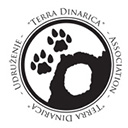HAVEN FOR PERUĆICA AND PANČIĆ SPRUCE
There are those who prefer gentle valleys with fields of flowers and lakes, some lean towards harsh rocky terrains underfoot and towering peaks with breathtaking views, while others seek a refuge in dense forests where the sun plays peek-a-boo with leaves. Reconciling all these different tastes can be challenging. We know of only one park that can do that — the oldest national park in our country, Sutjeska.
This trove of natural treasures highlights the queen of the mountains — Zelengora, with its glacial lakes; one of the best-preserved primeval forests in Europe — Perućica; the canyons of Sutjeska, Hrčavka, and Jabučnica; and, of course, the highest mountain peak in Bosnia and Herzegovina — Maglić (2,386 meters).
Under the Flowery Blanket
So, let’s take it step by step… Zelengora is one of the most beloved mountains for many in our country. It provides excellent conditions for hiking but is also largely accessible by off-road vehicles. Its pride are the glacial lakes — its “mountain eyes”. Not all lakes are ideal for swimming, but they are exceptionally photogenic. Among the most popular hiking destinations on Zelengora are the lakes Gornje and Donje bare. With its flowery blanket, Zelengora is often considered a gentle mountain. However, if you’re looking for a bit more excitement, you’ll find it in the canyon of the Hrčavka River. Locals will tell you that this is the last conquered canyon in Europe since canyoning tours have only become available in the last few years.

Željka Kočić Nikolić
Heart Is Full Like a Lake
Maglić, the highest mountain in our country, serves as the natural border between Bosnia and Herzegovina and Montenegro, offering the most appealing ascent in the Park. It is challenging and partially secured with ropes. We can’t guarantee stunning views, as the misty cloak that often envelops it is the reason it bears the name Maglić (derived from “mist”). If you’re fortunate, you’ll be welcomed by landscapes of Volujak and Zelengora, as well as the canyons of Sutjeska, Drina, Piva, and Tara. Your heart will be as full as the one nature painted beneath you — the heart-shaped Trnovačko Lake in neighboring Montenegro. If, after this strenuous ascent, you want to freshen up a bit, you can descend to the lake without a passport.

Iman Azganović
The Lungs of Europe
The centerpiece of this Park is Perućica, one of the largest and oldest primeval forests in Europe. If the Amazon rainforest is called the Lungs of the Planet, spread across 1,434 hectares, Perućica is rightfully considered the lungs of Europe. It is believed to be over 20 thousand years old, and preserving it in its original state is the mission of the National Park. Nature reigns in this primeval forest — growth, development, decay, rebirth. Humans do not interfere, only adapt. Some parts are entirely inaccessible and unexplored. Visiting the primeval forest without a guide is strictly prohibited.
The crown jewel is undoubtedly the 75-meter-high Skakavac waterfall. The path to the waterfall is very inaccessible, but a beautiful view of it unfolds from the Dragoš Sedlo viewpoint. From this spot, you have a panoramic view of the entire primeval forest, as well as the mountain ranges of Maglić, Volujak, and Zelengora.

Adnan Bubalo
Mountain Waters
Alongside Hrčavka River, adrenaline on the water is also provided by the Tara, Sutjeska, and Drina rivers. Rafting, canyoning, and kayaking are the best ways to truly get to know them. Wild rivers, wild nature, the wild beating of the heart, yet at day’s end — a sense of peace, the sound of crickets, crackling fire, and murmur of plans for a new adventure in this Park. Because there’s always at least one more.
Sutjeska is a haven for over 2,600 plant species, including 330 endemic, rare, and endangered species. It is also the habitat of the Pančić spruce, which scientists consider a “living fossil” of the world’s flora. This is a relic from the Tertiary period that became extinct everywhere else during the Ice Age, except in today’s small areas of Serbia and Bosnia and Herzegovina. This park is also home to numerous animals, from chamois, roe deer, wild boars, wolves, brown bears, badgers, and foxes, to 114 species of birds, both indigenous and migratory. Protecting the richness of the flora and fauna was the main motive for establishing the Sutjeska National Park.

Zorana Kerleta
Find this QR code on the location:

































